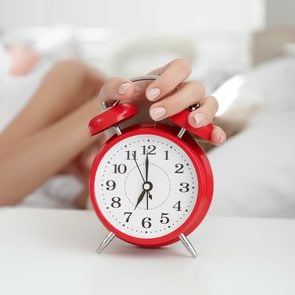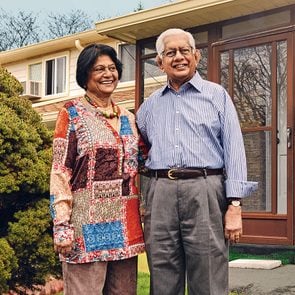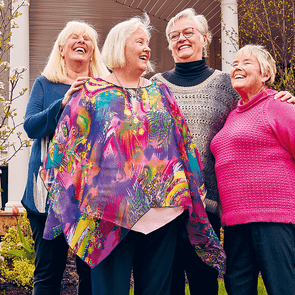Music can make you laugh, make you cry, give you chills, shake your booty, or—as anyone who has ever attended an evening performance at the symphony knows too well—put you to sleep. Emerging research from sleep scientists around the world says that there’s a good reason for this, and now you can exploit it to make your own bedtime even cozier.
Music has been used in healing ceremonies for thousands of years and across cultures—but more recently, it’s been seriously studied as a sleeping aid. Researchers in a study in Taiwan found that study participants who listened to music for 45 minutes before bed every night for three weeks fell asleep more quickly, slept more deeply, and felt better the next morning. Those findings are consistent with several other studies, along with one intriguing observation: The songs they listened to were all set at tempos between 60 and 80 beats per minute—our approximate heart rate when falling asleep.
That’s right: You can literally trick your body into relaxing by syncing your heart rate with peaceful music. In this way, listening to music becomes a form of meditation; by mindfully listening to your surroundings, your heart rate slows, your blood pressure lowers, your anxiety abates, and life becomes a peaceful song. (Here are more secrets for a good night’s sleep.)
Of course, the same is true of energetic music: The Royal Automobile Club Foundation for Motoring ranked Wagner’s “Ride of The Valkyries” as the world’s most dangerous song for motorists, thanks to a frenzied tempo (nearly 100 bpm) that challenges drivers’ normal sense of speed. (Saying “Sorry, officer, I was just Wagner-ing” probably is not going to get you out of a speeding ticket.)
Armed with findings about the irresistible link between backbeat and heartbeat, sleep therapists have even begun collaborating with musicians to create what could become known to history as the chillest music ever. A few years back, the English trio known as Marconi Union worked with the British Academy of Sound Therapy to create an eight-minute instrumental track called “Weightless,” designed to lull the listener into relaxation through proven heart-rate-lowering sounds and tempos (beginning at 60 bpm, and stealthily slowing to 50 bpm by the end).
And it worked, too. In a recent UK study, participants challenged with solving difficult puzzles while listening to various types of music showed a whopping 65 percent reduction in anxiety (and therefore an improvement in performance) while listening to “Weightless.” (That pretty much makes “Weightless” the anti-Valkyrie.) As an addendum, study moderator Dr. David Lewis-Hodgson of Mindlab International even said: “I would advise against driving while listening to the song because it could be dangerous.”
Want to boost your relaxation before bedtime? Make this your official playlist of music to help you fall asleep:
- “Weightless” by Marconi Union
- “Clair de Lune” by Claude Debussy
- “Canzonetta Sul’aria” by Wolfgang Amadeus Mozart
- “Nocturne in E Flat Major Op. 9 No. 2” by Frederic Chopin
- “The Boxer” by Simon & Garfunkel
Sleep tight!
Now that you know the best music to help you fall asleep, check out our ultimate sleep hygiene checklist.
That rhubarb in your garden is ready—so what’s the best way to harvest it? You might assume that it’s fine to simply cut the stalks off, but wait!
When stalks are sliced off with a knife, the part of the stalk left behind withers away. In contrast, twisting and pulling off the stalk allows it to separate from the bottom of the plant near the roots. This tells the plant to regrow a new stalk in its place, giving you a more fruitful harvest and a healthier rhubarb plant.
How to Harvest Rhubarb
Harvesting rhubarb is all about the pull and twist. Find a stalk on your rhubarb plant that’s ready to be picked. Grasp the stalk near the bottom. Lean it to the side and in one motion gently twist and pull the stalk up. The stalk will pop and separate from the rhubarb plant at the root, and come cleanly away.
The twisting and pulling motion should be gentle. If the rhubarb stalk doesn’t come away immediately, grasp it lower and try leaning it in the other direction. If you find that the whole plant is coming out of the ground when you pull the stalks, pack it more firmly into the soil around the roots.
Remember that only the rhubarb stalks are edible, so cut off the rhubarb leaves and discard them.
When to harvest rhubarb
Give new rhubarbs plants at least a year before harvesting for the first time. When you’re looking at the stalks, the colour doesn’t indicate readiness, so don’t worry if your rhubarb stalks are not completely red. Instead, look at the length. The stalks are ready to harvest when they’re between seven and 15 inches (18 to 38 centimetres) long.
The best time to harvest rhubarb is during the months of May, June and early July. After this, it’s best to let the plant be, so it can regrow and recharge to survive the winter. You can cut the flower stalk away before it blooms to help extend the harvesting season.
When you’re gathering your rhubarb, remove no more than two-thirds of the plant. You want to be sure there’s some left to grow back next year!
Now that you know how to harvest rhubarb, check out our favourite rhubarb dessert recipes.
I was never a cat lady; I grew up with dogs only. My first cat came as a surprise when a colleague said he was giving his cat up, since they really didn’t like each other. The cat was named Santos and he was pure black with copper eyes. In a spur-of-the-moment decision, I said I’d take him—and the battle to get along began. He stayed on one side of the condo and I stayed on the other. If I approached him, he would hiss and try to slash at me. I took the hint and let him be. At night, I started to feel him come onto my bed—as long as I didn’t acknowledge him. By morning, he was gone again.
Slowly but surely we bonded and he became my best friend. He had a “charming” habit of expressing his love for me by head-butting my nose. It was a less than ideal way to wake up. He grew to a massive size—12 pounds of lean panther, and so long that when he draped himself across my shoulders, his head and feet would hang down to my chest. The vet loved him, too, as he would jump onto her shoulders and she would wear him like a scarf.
“Sans” seemed lonely when I went to work, so I set out in search of a friend for him. At the SPCA, I started to look at kittens. One was hanging upside down on the bars of his cage, screaming at people. He was black with a little white spot on his chest. Unable to get him out of my thoughts, two days later, I returned and brought him—my little Zac—home to meet Sans. Zac was sweet and small, and once he was home, he stopped screaming. Sans took one look at him and whacked him, hissed and bit me on the ankle. Needless to say, he was not impressed. For the next two weeks, Sans terrorized poor Zac. If Zac was sleeping, Sans would do a drive-by, whacking him on the head and running off. Zac finally started to sleep under my hair for protection.
Eventually they bonded, and all was happy in the house. Sadly, Sans got really sick and I had to say goodbye to him. I was crushed; this unexpected creature had worked his way into my life and I was so sad to see him go. Zac had always had him as a buddy, and soon went into a depression. He refused to come out from under the bed and he stopped eating. I was so worried, I decided to start looking for a new friend for him.
I learned that neighbours of a friend had a litter they were giving away. I went to see the kittens: there were two black ones, one white-and-grey and one orange. They were only four weeks old, so they wouldn’t be released for another two weeks. I focused on the black kittens but was told that they were already promised to others. I felt a tug on my back leg but ignored it. I thanked the people, and was leaving when the white-and-grey kitten climbed up the back of my leg, skittered across my back, clawed herself up my chest and proceeded to suck on my lower lip. I had been chosen—and I was fine with it.

Two weeks later, I brought the kitten, Newt, home. Zac was instantly intrigued; I’m sure he figured that she would be his to boss around. Oh, how wrong he was! She pushed him around and set about claiming the entire apartment. But he loved to groom her, and she loved it in return, so they bonded quickly.
Suddenly, Newt was lethargic, shedding hair and miserable. I tucked her into my pocket and took the bus to the vet. He told me not to hold out too much hope. He said she had a bladder infection and gave me the medicine for free, with a reminder that cats have nine lives and a hope that this was just one of them. I was crushed; she’d quickly become my shadow and was a great snuggle bug. While Zac loved to sit under the lampshade and stare at the bulb, Newt was always on my chest, purring.
More Kitties to Come?
For three days I gave Newt her pills. Each time I came home from work, I was scared of what I’d find. On the fourth day, when I got home, she wasn’t on the couch. I looked high and low but couldn’t find her. Zac was screaming his head off, pacing back and forth under the window. Frantic, I was trying to figure out if she could have slipped out of the apartment. I then heard a chirp. I looked up and there was Newt. She was on top of the curtains, looking down at me. She leaped off and landed in my arms, purring and nuzzling my chin. From that day on, she ran instead of walked, bounced, fetched tinfoil balls and snoozed in my workboots, head down. She would lay in front of the fireplace, soaking up the heat till she singed her fur. I would come home to find ash everywhere, my once white-and-grey cat now a charcoal ball with claws.
When I met Dave, my future husband, Newt was enthralled by him. She’d lie on his chest as he napped, looking down his throat, and then would look at me in shock. He snored and it was nothing she’d ever heard before. She tucked her head under his chin and purred as loudly as she could. She loved him so much, she would wear his dirty work socks around her head like a bonnet as she walked down the hallway. If one fell off, she’d drag it into the living room like it was her kill. Those socks certainly stank like a dead animal, so I can understand her confusion.

When Zac passed away, Newt was devastated. Her grooming buddy was gone, so I had to find her a new friend. Enter Foozball. He came into the house like a tornado and never stopped. He was black, lean and a total snob to most people. He loved our dog Brynn and the two would take turns chasing each other around the house and then box around the chairs.

From one spontaneous offer to take a cat, I’ve been lucky to have enjoyed four so far. Each has left me with some wonderful memories. Each had their own personalities and quirks that made them unique. I don’t have any at this moment. I am still trying to convince Dave that we could get another one. So far, he has not been receptive to my whining. I can’t say my cat days are over: If I find the right one again, the one that picks me, how can I say no?
Next, read the heartwarming story of a woman who adopted her first dog at 65—and forged a powerful bond.
The travel bug hit me hard when I retired, egging me on to see the world and what it had to offer. In February of 2018, I decided the time was right to take a trip to the land Down Under.
The trip checked two items off my bucket list—to meet with my “rellies” in Australia and to capture the essence of the country through photography.
In the early planning stages, the idea of a road trip came up. I gave it some serious thought, especially after my cousin Tom, who was living in Melbourne, decided that he was good to go.
Tom was just as interested as I was in seeing the rellies. Before that, however, he wanted to take a major detour to see his longtime friend Ella Miller.
She lived in a place I knew nothing about, the island once known as Van Diemen’s Land: Tasmania. Given the high priority Tom placed on visiting his friend, I agreed to adjust my plans. After all, I was looking for adventure.
On March 21, 2018, I arrived—jet-lagged—in Melbourne. For the remainder of the day and the middle of the next, family stories were traded around the kitchen table with my aunt Teri and cousins Juliet and Tom. This naturally brought about an insatiable hunger and thirst that could only be satisfied by Teri’s homemade Hungarian cuisine and an ample supply of red wine.

The next evening, Tom and I packed our clothes and camera gear into his car and drove to the Port of Melbourne to catch the Spirit of Tasmania.
The ferry across the Bass Strait was uneventful but entertaining. A guitarist in the lounge sang “oldies and goldies” into the wee hours. Beer in hand, we hummed along until neither of us could keep our eyes open.

Welcome to Tasmania
When we disembarked in Devonport, the weather was typical of autumn—overcast, drizzling and cool. Tom and I were groggy from our overnighter, but when we reached our first point of interest, Cradle Mountain, we took a short hike to the Dove Lake Boatshed. The park was nothing short of mesmerizing. In my mind, this was a place that a movie sequel to the Lord of Rings trilogy could be filmed—Peter Jackson, are you listening?

After a short stay in the park, we headed to Launceston, the home of Ella and Ken Miller.
In addition to being a longtime friend, Ella was a gardener, an accomplished artist, a retired school teacher and, like Tom and myself, a refugee of the 1956 Hungarian Revolution. She treated us to a feast of cabbage rolls and schnitzel, with cherry strudel—my favourite—for dessert.
The next morning, Tom, Ken and I toured the highlights of Launceston—the Duck Reach Power Station and Brady’s Lookout—before we finally had to say our goodbyes to the Millers.

Exploring Van Diemen’s Land
After driving a few short hours, we reached the welcoming gates of Freycinet National Park. A hike up to the Wineglass Bay Lookout was in the cards as a sign at the gate showed that the peak was a mere 230 metres away. We took the trail, an arduous uphill hike and definitely not a “walk in the park.” Nevertheless, it offered an unforgettable view of Wineglass Bay.
We continued on our journey to Port Arthur, the site of the former Port Arthur convicts’ colony. For prison guards and the social elite, the grounds provided manicured gardens, walkways and chapels—for those incarcerated, it was hell on Earth.
At nearby Eaglehawk Neck, we saw a landscape that might be described as one of utter desolation while being uniquely beautiful at the same time. It gave me a sense of what the world might look like following a nuclear holocaust.

End of the Line
We moved on to Hobart, the capital of Tasmania, taking some downtime to walk the corridors of the city, see the Victorian architecture and have a cappuccino. When we were done, we made a beeline for Mount Wellington. The road to the top was long and winding, but at an elevation of 1,271 metres above sea level, it provided an incredible view of the city and countryside.

Next on our itinerary was Franklin-Gordon Wild Rivers National Park. Here we boarded the West Coast Wilderness Railway—an 1800s-era steam locomotive that chugged slowly through a virgin rain forest. At the end of the line, Dubbil Barrel Stop, the train’s locomotive was turned around by hand for its return journey to the home station. Wow! Who would have known?
After seeing the former Sarah Island Penal Colony within the park, Tom and I called it a day and rushed back to Devonport for the ferry back to Melbourne.
The week Tom and I spent touring Tasmania was long and hard, but the trip was worth every bit the effort we put into it. I would do it again in a heartbeat. But next time at a more leisurely pace—maybe over a month or longer.
Now that you’re familiar with the attractions of Van Diemen’s Land, check out 10 of the world’s greatest hikes.

Playing casino games for real money is exciting – but finding the best real money online casinos in Canada can be a pain when there are just so many out there.
So, we’ve been on the lookout to find the top online casinos around right now. We’ve ranked a whole bunch based on a number of important criteria, and the results are in.
Based on its choice of real money online casino games and brilliant bonuses, our top pick overall for Canadian players is Jackpot City.
But, of course, it’s different strokes for different folks, so make sure you stick around for the rest of our top picks.
Best Real Money Online Casinos available in Canada
- Jackpot City: Best overall
- PlayOJO: 2,000+ real money games
- BetOnline: Fantastic poker app
- Bodog: Great odds on 30+ sports
- Spin Casino: Top choice for jackpots
Canadian-friendly real money online casinos on our list bring thousands of exciting games, generous bonuses, and so much more to the table. Let’s explore them all together.
Are you suffering from a gambling problem, or do you know someone that does? If so, it’s crucial to call the Gamblers Anonymous at 1-626-960-3500 to seek help from one of the numerous advisors on the ground. Speaking to these professionals is instrumental in making gambling a safe venture for you and your loved one. You also have to be aware that gambling sites and other related products are for those aged 18 and above. Non-Ontario only.
Several casino sites listed in our reviews might not be available in your region. To this end, you might want to go through your jurisdiction’s local laws and rules to have an idea of online gambling’s legality.
If you’d like some top-notch information that focuses on gambling and everything in-between, check out these organizations:
1. Jackpot City – Best Real Money Online Casino in Canada Overall

Pros:
- Games by 16 world-class developers
- Huge range of e-wallets
- Over 50 live dealer games
- Dedicated mobile casino apps
- Over C$30 million in jackpot prizes
- C$1,600 welcome package
Cons:
- Doesn’t offer many bonuses for regular players
- Simple website design
As an all-rounder, we’re confident that Jackpot City is the best online casino in Canada for real money. We don’t say that lightly at all, and here’s why.
Bonuses: 4.6/5
If you’re new to Jackpot City, you can grab a 100% match deposit bonus of up to $400 when you put down your first, second, third and fourth payments. That’s a total of up to $1600 in bonus funds — not a bad welcome bonus at all!
Once you become a regular user of the site, you can take advantage of the daily match bonus, which is unique to each player. Just keep in mind that the more you spend, the bigger your match bonus will be the next day.
Beyond that, there isn’t too much more in terms of bonuses for regular players besides the VIP program, which is, in fact, pretty generous. You’ll immediately get 2,500 points and get started at the Bronze level, from which you can earn points and exchange them to bet credits and rise through the ranks.
Game Selection: 4.9/5
The list of software providers bringing the games to Jackpot City is very impressive. It features the likes of NetEnt and Microgaming, two of the biggest names in the gambling industry in Canada.
All in all, these companies have brought a total of nearly 500 games. It’s not the biggest game portfolio in the world, but due to the guaranteed quality here, we’re pretty confident that most Canadian players will never get bored.
The live side of things is mostly taken care of by Evolution Gaming, a provider often considered to be the king of live dealer games. In total, there are over 50 live games, which is a really impressive haul.
Banking: 4.9/5
Jackpot City sure does offer a lot of ways to pay. You’ll be able to transact with VISA, ecoPayz, Paysafecard, Instant Payments, Interac, Neosurf, Much Better and more, and you can place deposits from as little as $5.
There are no instant withdrawals as Jackpot City has a mandatory 24-hour pending period, but you should see that your money is transferred very quickly after this with most of the payment methods.
You can do all this banking on either the desktop website or the dedicated mobile app, downloadable straight to your smartphone. If you do want to take your games on the go, we certainly recommend this, as it is a pretty neat piece of software.
Overall: 4.8/5
Having been around since all the way back in 1998, Jackpot City is one of the oldest online casinos in Canada. It’s managed to keep up its reputation for all that time, and the points noted above are the key reasons for that.
>> Claim up to C$1,600 [Jackpot City] <<
2. PlayOJO – Best Variety of Real Money Casino Games available in Canada

Pros:
- Over 2,000 games to choose from
- 80 no-wager free spins with your first deposit
- Fast withdrawals (within a few hours)
- Downloadable app for mobile devices
- OJOPlus program for regular players
Cons:
- Desktop site could use improvement
- Limited payment options
The brilliant PlayOJO is often considered to be the best bingo site, but that’s not doing it justice. In fact, it’s our favourite online casino out there for games, period.
Bonuses: 4.7/5
Upon placing your first deposit of $10 or more using the code OJO80, you’ll get 50 free spins for Thor and the Trials of Asgard credited straight to your account. Once you play them through, you can claim an additional batch of 30 free spins via the Kickers section.
But the best thing about this welcome bonus is the fact that there are no wagering requirements at all. Any winnings you make from these 80 free spins will be credited straight to your account as cash, meaning they’re instantly withdrawable.
On top of that, the winnings from these free spins are uncapped, which is rare for a bonus like this. Hit the jackpot, and the winnings are yours.
Game Selection: 5/5
The total number of games at PlayOJO stands at a mighty 2000+. That consists mostly of real money online slots (there are nearly 1900 of them, in fact), but Canadian players will also be treated to over 50 live casino games and even 7 bingo games.
Are they good games, though? Well, yes. The list of software developers here is hugely extensive and features names like Pragmatic Play and Play ‘n GO. This tells us that we’re going to see a lot of high-quality games in this portfolio.
The majority of these games are also available on the mobile app, which is well worth downloading. However, the desktop site is a little clunky, so we recommend accessing this online casino on your phone.
Banking: 4.7/5
The number of payment methods at PlayOJO is far short of what Jackpot City has to offer, but that’s not to say there’s not a fair amount of choice.
We counted nine payment methods in total, and they included Interac and Jeton, in addition to a few more. You’ll need to meet a minimum deposit threshold of $10.
Interestingly, PlayOJO processes withdrawals within a few hours, which is super quick for a real money casino. A lot of online casinos like to hold onto your cash for longer than this before they process it.
Overall: 4.8/5
Landing PlayOJO at second place in our list of top real money casinos available in Canada was a no-brainer. It was super tough to make the call vs Jackpot City, but the bottom line is that they are two of the best online casinos available in Canada right now.
>> Deposit C$10 to claim 80 wager-free bonus spins [PlayOJO] <<
3. BetOnline – Best Real Money Online Casino available in Canada for Poker

Pros:
- Fantastic poker app with daily tournaments
- Extensive range of sports betting markets
- Lots of crypto payment methods
- Top slot games from Betsoft
- Up to $1,000 welcome bonus
Cons:
- Credit card deposit fees
- Smaller game library
If you like to enjoy both sides of the online gambling world, online casino gaming and sports betting, you’re in the right place with BetOnline. But don’t forget the poker section – it’s one of the strongest out there.
Bonuses: 4.8/5
Use the code BOLCASINO when you place your first deposit here, and you’ll get it matched 100% up to $1000. You can then come back and get the same offer two more times for a total of $3000 in bonus cash.
The wagering requirements for this matched deposit offer are pretty reasonable at 30x. Overall, that’s a little below average, and it’s impressive for a bonus of this size.
If you prefer, you can get the sports betting welcome bonus of 50% up to $1000 with the code BOL1000. The rollover for this one is a lot lower at 10x, although you will need to put down a pretty high minimum deposit of $55 to qualify.
Game Selection: 4.5/5
BetOnline doesn’t offer a whole ton of games, with a little over 300 to its name. There are some good ones, though, including some fantastic slot games from the top-tier software provider that is Betsoft.
Perhaps the best thing about the BetOnline games portfolio is the poker section. There are 30 high-quality poker games and even a downloadable poker app for desktop and mobile devices.
And, of course, there’s sports betting. You’ll find a brilliant range of real-world sports betting markets at BetOnline and great live betting tools as well.
Banking: 4.6/5
We’re really impressed by the range of payment methods at BetOnline. Canadian players here can bet with a wide range of eWallets and even a handful of cryptocurrencies, such as Stellar, Dogecoin, Chainlink and, of course, Bitcoin.
This means you can get fast withdrawals within an hour. That’s not the case with any payment methods outside of crypto here.
However, one payment method to avoid is a credit card. BetOnline will charge you a fee for all deposits made with this, so we recommend staying clear of it.
Overall: 4.6/5
Poker and sports betting are the dream combo for a lot of punters, and you won’t find a real money casino that does both better than BetOnline.
>> Grab your 100% up to $1000 welcome offer [BetOnline] <<
4. Bodog – Best Real Money Casino Site available in Canada with Betting Options

Pros:
- Reputable casino formed in 1994
- Low wagering on the welcome bonus
- Great odds on over 30 sports
- Fast withdrawals with cryptocurrencies
Cons:
- Limited range of non-crypto payment methods
- Dark website theme might put off some users
Having been around for over 28 years, Bodog is one of the oldest real money casinos in Canada. It’s certainly kept up appearances though, so much so that it’s our number 4 real money casino site.
Bonuses: 4.8/5
There are two parts to the Bodog welcome bonus: a 100% matched deposit of up to $600 that also comes with 50 free spins. We like the sound of that.
If you prefer, you can opt for the poker welcome bonus, where your 100% matched deposit limit is raised to $1000, but you don’t get the free spins.
The wagering requirements for the casino welcome bonus are only 25x, which is substantially lower than average. That’s great news for those concerned about being able to withdraw their bonus winnings.
Things are a little different with the poker welcome bonus, as here, you’ll get $5 in funds for every 150 reward points you earn from playing poker.
Game Selection: 4.5/5
You’ll find nearly 800 real money games in total at Bodog. Of course, there are casinos that have a much higher number than this, but we still believe it’s above average, and there’s more than enough to keep many players entertained here.
A lot of the games in the Bodog portfolio are developed by RealTime Gaming, a developer widely regarded as one of the best out there. Even though there are a few mediocre games on this site, you can bank on most of the RTG ones being very good indeed.
15 of the games on the site are poker as well, so Bodog is certainly a good option for fans of this particular game.
But the one category that stands out the most at Bodog is its great odds for over 30 sports. You can bet on anything and everything from football to volleyball and celebrity drama – with popular games getting over 200 betting markets each.
Banking: 4.4/5
Bodog supports a number of cryptocurrencies for deposits and withdrawals, including Bitcoin, Ethereum and Litecoin. If you like, you can use these for quick withdrawals.
Outside of crypto, however, there isn’t an awful lot of choice in the way of payment methods. The only other options are debit and credit cards, bank transfer and Interac, and for each of these, it could take a couple of days before you see the money.
Overall: 4.6/5
We’re pleased to see such a classic real money casino going strong after all these years, and there’s no sign of them letting off any time soon. Bodog could stay in our top picks for many years to come.
>> Enjoy up to $600 + 50 free spins [Bodog] <<
How We at Leanback Player Ranked the Best Online Casinos available in Canada for Real Money
Bonuses
Being introduced to a new real money casino with a great bonus is a pleasing experience, but only if the wagering requirements are sensible so that it doesn’t become too difficult to withdraw any winnings. With that in mind, we paid attention to both the size and the T&Cs of each bonus.
Game Selection
Online gambling sites available in Canada are often dominated by real money slot games, but there’s actually a lot more to it than that. The best real money sites will have plenty of video table games as well as a live dealer network with poker, real money blackjack and more.
Banking
Here, we’re looking for a wide range of payment methods to suit all kinds of Canadian players. And, there needs to be quick turnover for withdrawals so that the casino doesn’t hold onto your real money for too long unjustifiably.
Customer Support
You might encounter some issues even on the best platforms, and this is where customer support comes into play. We valued the quality of assistance, the speed of response, and the availability of support channels (like email, live chat, and phone) in our analysis.
Mobile Compatibility
We know that an excellent mobile interface can greatly improve the player experience. That’s why we factored in mobile compatibility, giving higher rankings to those casinos that deliver exceptional gameplay across smartphones and tablets.
Why Is Jackpot City the Best Canadian Real Money Online Casino?
The near-impeccable Jackpot City has blasted its way to the top of our real money casino rankings. But how did it do it? There are a few key reasons.
● Excellent banking flexibility: Jackpot City has a huge range of payment methods to choose from, and among them, you’ll find the most popular in Canada, like Interac and InstaDebit.
● High-quality casino games: Some of the best online casino game developers in the world have brought the games to Jackpot City, which is a great indicator of how good the games here are.
● Enhanced mobile experience: There’s a downloadable mobile app for Jackpot City (on both the App Store and the Play Store), which really elevates the mobile gaming experience. It runs smoother, looks better and is generally easier to use.
● Very reputable presence: Jackpot City is hugely well-regarded across the web. It has high reviews across the board and is largely appreciated by the Canadian online casino community.
Why Should I Play Real Money Games at Online Casinos available in Canada?
Casinos online are our favourite places to play real money casino games. Of course, there’s an appeal for the traditional, land-based casino, but there are a few key things that make the online world better:
● Play wherever you go: As long as you have an internet connection, you can access any of these real money casinos in Canada and play games.
● Better RTP rates for the games: Land-based casino slots can often have a Return to Player rate as low as 80%, whereas the average for real money online slots is around 95%.
● Easier to combine with sports betting: You won’t find many real-world casinos that let you bet on sports in the same seat. But you can do everything on the same device with many real money casinos like BetOnline.
● More choice of games: Why limit yourself to a handful of slots when you can have thousands of them? Online casinos are not limited by space, so they can have as many games as they want to.
Best Real Money Casino Games available for Canadian Players
Players in Canada have access to a variety of exciting online casino games, each with its unique appeal. Let’s dive into some of the top real money games you will find at these casinos:
Slots
The best online slots available in Canada are the heart of any online casino. Simple to play, they offer everything from classic 3-reel games to fancy video slots and big-payout progressive jackpots. It’s easy to see why they’re a player favourite.
Blackjack
Online Blackjack brings the timeless casino card game to your screen. With several versions available, there’s something for every blackjack fan.
Live Roulette
Roulette’s thrilling spin is as enjoyable online as it is in a physical casino. Live Roulette offers real-time gaming, and variants like American and French add to the fun.
Video Poker
Video Poker is a sweet spot for fans of slots and poker. Games like Jacks or Better and Deuces Wild are hits among players, combining strategy and straightforward play.
Baccarat
For a relaxed game, Baccarat is a top choice. Online Baccarat keeps the excitement of the original and offers variations like Punto Banco for added fun.
Guide to Playing Online Casino Games for Real Money in Canada — FAQ
Which are the Best Real Money Casinos available in Canada?
After reviewing hundreds of Canadian real money casinos in the past few months, we have discovered that the following are the best ones:
Are Real Money Online Casino Games available in Canada Rigged?
The answer depends on whether you’re playing games by popular software developers at a licensed and tested online casino available in Canada or you’ve just signed up with the first real money gambling site that popped up on Google.
For example, Jackpot City hosts games by the most popular software providers, is licensed in multiple jurisdictions, and is tested and approved by eCOGRA for fairness. Therefore, the games you find at this casino – and all others on our list – are not rigged.
What Does ‘RTP’ Stand For in Real Money Casinos?
RTP stands for Return to Player. The RTP of a casino game is the amount of a player’s stake they’ll get back from a game on average.
So, $1,000,000 staked over a 96% slot would, in theory, return £960,000. Just keep in mind that this percentage only comes through after thousands of spins by hundreds of players – it doesn’t mean that you’ll win $96 when you bet $100.
Can I Try Out Casino Games For Free Before I Play for Real Money in Canada?
Being able to try out a game for free before staking your own cash is a pretty cool thing. It gives you a chance to see if you like the game and even get a bit of practice in so that you know what you’re doing before you start playing.
Is Downloading Software From a Canadian-friendly Casino Safe?
Yes, downloading software from casino sites available in Canada is safe, provided they’re reputable and licensed. These casinos prioritize player safety and use strong security measures to ensure data protection.
In our list, each casino has been thoroughly vetted for safety and security. They use advanced encryption protocols to protect your personal and financial information. Additionally, they are licensed and regulated by trusted gambling authorities.
So, rest assured, the software you download from these casinos is secure and reliable.
Top Real Money Casinos Available in Canada, Compared
Before we wrap up, here are the key talking points on our top picks and another look at their welcome bonuses.
- Jackpot City: Our top pick has it all – real money games by the best providers, the biggest progressive jackpots, and two mobile casino apps for iOS and Android. Your first four deposits will be matched 100% up to $400 at Jackpot City.
- PlayOJO: The games portfolio at PlayOJO is second to none, and there’s a brilliant welcome bonus there, too – 80 free spins with absolutely no wagering when you deposit for real money at PlayOJO!
- BetOnline: A gem for poker and sports fans, offering high-quality games, daily poker tournaments, and wide sports markets. Use code BOLCASINO for a 100% welcome bonus up to $1,000.
Ready to Explore the Best Real Money Online Casinos Available in Canada?
So, what’s it going to be? We’ve looked at some incredible real-money online casinos available in Canada today, and now it’s over to you.
While Jackpot City took the gold medal in fine style thanks to some top bonuses and games, it was no easy decision for us. PlayOJO, Bodog, and the rest completed a strikingly strong nine. The bottom line is that any of these online casinos will serve you well.
That is, of course, if you continue to gamble responsibly. Have fun!
I’m a walker, logging an average of 9,000 steps a day several times a week around my Toronto neighbourhood. One of walking’s great charms for me is that you don’t need equipment. But on recent trips to Copenhagen and Stockholm, I noticed tall, fit Scandinavians striding along on city streets with poles, as if they were cross-country skiing without any snow. It was a revelation to learn that the addition of the poles makes it a more vigorous, full-body exercise than simply walking—and, as a 76-year-old looking to stay healthy while enjoying the outdoors, I decided to give a try.
There’s plenty of help online for the novice Nordic walker: stand tall, swing your arms out as if to shake hands and plant your poles with vigour. Then there’s the little matter of the glove-like strap on the pole. This allows the walker to grip the pole when thrusting forward and then relax that hand as the other hand pushes forward—a feat of coordination that builds stronger muscles.

Benefits of Nordic Walking
For a warm-up, I started in the wimpiest way imaginable: Nordic walking down the hall that extends from my front door to the deck. In case you’re tempted to sneer, that measures 19 good strides and it wasn’t easy. Back and forth down the hall, as I struggled to propel the right arm out while the left leg stepped—all while gripping and releasing properly—I was reminded of the poem about the centipede who went all to pieces when asked how she walked. Coordinating the movements wasn’t my only problem. As someone who can walk eight kilometres briskly without apparently raising my heart rate, the novel use of my arms and upper body was surprisingly strenuous. After half an hour, my heart was pounding and I was sweating, but I still wasn’t much good.
I pressed on, because there’s no arguing with the proven benefits of nordic walking. Nordic walkers’ upper-body exercise increases their heart rate significantly more than walking without poles. There’s up to 23 percent more oxygen delivered to the tissues. And according to Boston cardiologist Dr. Aaron Baggish, with poles “you’re engaging 80 to 90 percent of your muscles, as opposed to 50 percent, providing a substantial calorie-burning benefit.”
Cross-country skiers in Finland were early practitioners of the sport as a way of training off-season. In the early 1990s, it was adopted in North America as a rehabilitation tool. Peter Burrill, head of the Nordic Pole Walking program at InsideOut Physiotherapy in Toronto, says he’s seen the exercise speed up the post-surgical recovery of patients with new hips and knees. It also helps people with Parkinson’s: “We put poles in their hands and it’s amazing because they start walking with real rhythm.”
Meanwhile, out on the winding path around the cemetery near my house, I was still advancing three steps and falling back two. But after a few more clumsy days of being convinced I would never master the technique, suddenly everything clicked. Not only was I able to coordinate the movements, I was happily aware that my heart, arms and core were getting a workout.
Thinking back on those confident Nordic walkers I saw across the ocean, I wish I could report that participating in the sport for 45 minutes a few times a week has made me tall and blonde—but something even better has happened. I found exercise that adds an upper-body, aerobic component to my love of walking and it’s one I expect to enjoy for years to come.
Now that you know the benefits of Nordic walking, find out what happens when you start walking 10,000 steps a day.
Muriel Shaw had always said the only way she’d leave home was “feet first.” For Shaw, a retired British Columbia Institute of Technology clerk in her 80s, home was a double-wide trailer in Coquitlam. Shaw was living an independent life and had endured a series of challenges, including the loss of her partner, Mel, in 1996 and breast cancer when she was in her 60s. At the end of 2010, Shaw didn’t seem herself: she was anxious and confused. Chris Jarvis, her youngest son, said she was “just acting strange.” The family took her to the hospital.
After Shaw was admitted, hospital staff decided to give her a capacity assessment: a common evaluation administered to people who seem disoriented. The goal is to determine whether a person has the ability to understand information and foresee the consequences of their actions or decisions. And, though doctors often give these assessments, the responses lead to a legal outcome rather than a medical diagnosis. If the assessor determines that a person is incapable of making some or all of their own decisions, a “certificate of incapability” can then be issued. These certificates have different names depending on the province, but they all have more or less the same result: from that moment on, some or all of a person’s autonomy may be taken away for good.
Being deemed incapable means that a person’s life decisions—what they spend their money on, what health care they receive, where they call home—may be delegated to another party. In some cases, that proxy is a family member; in others, it is the provincial public-guardian system, whose staff may meet with the person rarely, if ever. The system is designed to protect against elder abuse and errors in judgment; it is an attempt to safeguard some of society’s most vulnerable, but it risks doing so at the cost of their liberties.
After her capacity assessment, Shaw was deemed incapable. (Jarvis told me that she was showing symptoms consistent with early-stage dementia.) The people around her immediately began trying to work out who would make decisions on her behalf. She had three children, and they had different ideas about what would be best for her. Jarvis said that social workers and hospital staff determined there was no suitable place for Shaw to live among her family, and though she wanted to remain at home, her new care workers wouldn’t allow it.
Shaw was moved to a long-term care facility. She started writing in a journal there, in June 2011. She seemed to want to make the best of her situation, and on the first page, she put down a rosy title for her project: “New Beginning!” But her entries outlined a growing list of concerns: “My small room lets me see outside, food is available, etc., but I am still very sad and lonely,” she wrote. “Wish I could be home rather than in the hospital (or whatever this place is called!).” While Shaw was getting acclimatized to her new living situation, Jarvis and his siblings argued over how their mother’s money was being managed. To settle the matter, Jarvis asked B.C.’s Public Guardian and Trustee (PGT) to become involved. The B.C. PGT is a government-designated corporation that steps in when there isn’t a family member or close friend available to take responsibility for a person deemed incapable. “If we’d had family harmony and money, this would not have happened,” Jarvis said. “It wasn’t ideal, but what was the alternative?”
The need for reform
Shaw is not alone in spending her older years deemed incapable and living under the oversight of the PGT. In Alberta and B.C. respectively, public guardians reported 7,832 and 7,904 adult clients from 2017 to 2018. The public guardian in Ontario managed the finances of approximately 12,500 people in 2019, about half of whom were seniors. Billions of dollars—savings accounts, assets, pensions—are managed by public guardians across the country.
In recent years, auditors general and ombudspersons have raised concerns about the inner workings of the closely entwined capacity-assessment and public-guardian systems. Some seniors find that, once declared incapable, they are unable to challenge the decision. There has been case after case of mismanaged finances and contested spending. In Ontario, the auditor general found that over $1 million of assets managed by the PGT was lost between 2015 and 2018 because of staff mistakes. In one instance, a packet containing $645 worth of jewellery was found in a PGT office, and employees had no idea which client it belonged to. Errors like this are not confined to one province: reviewers in P.E.I., B.C., Alberta and New Brunswick have all stated that their public trustees may not be properly protecting or administering their clients’ finances.
It can seem like a great deal of attention is paid to other institutions that house vulnerable segments of the population, such as children in daycares. But there’s no future in aging; there is next to no potential that a senior might one day cure cancer or be the next prime minister. Reform in eldercare may be desperately needed, but it hasn’t been forthcoming.
Cognitive tests for seniors
Determining mental capacity can be a puzzle. To test for a fever, medical staff can take a person’s temperature; for diabetes, they can do a blood test. Capacity, on the other hand, has no standard unit of measurement. Sometimes the practice may seem more like an art than a science.
In Canada, depending on the province or territory, capacity assessments can be administered by a doctor or a nurse, a social worker or a psychologist, an occupational therapist or, in rare cases, a member of the clergy. Some assessors may use what’s known as a Mini-Mental Status Examination. In this evaluation, seniors are asked the month and the season. They are asked to spell “world” backward and forward and given a time limit. They are asked what province they’re in, to repeat the phrase “no ifs, ands or buts” and to fold a piece of paper in half and put it on their lap or the floor. Other assessors may use the Montreal Cognitive Assessment, in which the subject is asked to draw a clock face and to name as many words that begin with the letter f as they can in one minute. Other patients may be assessed on a geriatric-depression scale, where they are asked if they feel “pretty worthless” or if it’s “wonderful to be alive.”
Being on the receiving end of these questions can be rattling—and not answering to the assessor’s satisfaction can influence whether a person goes home at the end of the meeting. Experts have raised concerns about the efficacy of these tools and caution that assessors may be relying too heavily on them. Laura Tamblyn Watts, president and CEO of the seniors’ advocacy group CanAge, says that capacity should be thought of as more like a dial: “People are more and less capable of doing some things and not others.”
As she explains, many of us experience some level of uncertainty in our day-to-day lives; we all get confused and ask ourselves questions. Did I pay that bill already? Did I turn off the oven before I left home? But determining when exactly these sorts of questions become a sign that some greater function has been lost is far from straightforward. Even those with dementia don’t fully lose their faculties overnight.
Capacity often comes in fits and spurts and can be influenced by health and environment. Problems with sleep or blood sugar can temporarily affect a person’s state of mind. Seniors with dementia may experience a phenomenon known as sundowning, a decline in function that occurs later in the day.
And then there are the medications. According to the Canadian Foundation for Healthcare Improvement, in 2018, one in five people in long-term care were administered antipsychotic drugs despite not having any diagnosis of psychosis. These drugs can increase fatigue and confusion and are known in the industry as “chemical restraints.”
How a person performs on a capacity assessment can be influenced by whether they’ve recently experienced a traumatic event, whether they trust their assessor or whether they are hard of hearing. Some advocates for seniors argue that people may even be found incapable without being properly assessed by a doctor at all.

“I want out of this place!”
Ruth Adria, a retired registered nurse in Edmonton, says that she believes this was the case when a woman she knew—I’ll call her Martha—was deemed incapable over 10 years ago. As Adria tells it, Martha was 85 and lived alone in her bungalow. She kept busy, filling her days with errands, tending to her backyard garden and regularly stocking her basement with jars of homemade preserves. Martha had grown up an orphan in Europe and knew how to look out for herself.
Then, one day, she hurt her foot and was admitted to her local hospital. While Martha was there, health care workers raised concerns about the cleanliness and safety of her living conditions. Martha never went home again. She lost control of her finances and was placed in a nursing home. According to documents that Adria saved, Martha’s bank account was billed $2,000 per month for her new room—a shared space in which only a curtain separated her from other residents. Martha’s house was emptied, her preserves thrown away.
Throughout the ordeal, Martha maintained that she was being unfairly “locked up,” according to a letter she wrote to her doctor that Adria kept. Martha knew what was happening: she complained that she wasn’t allowed to attend Mass, that her only exercise was “walking the corridor aimlessly,” and she argued she would be better off at home. “I want my freedom!” she wrote. “I want out of this place!” She never did get out.
With so many complicating factors that can influence capacity, and with a person’s rights on the line, the quality of assessments deserves more scrutiny. Adria now advocates for capacity assessments to be recorded and transcribed so families can have access to the basis of their family member’s certificate of incapability. As it stands, many written assessments are vague, with little information about how conclusions were reached.
In 2018, Ontario’s auditor general found that outside experts identified concerns in almost half of the assessors they evaluated. They cited a “lack of understanding of relevant legislation; asking subjects questions that lacked sufficient depth; not explaining why they found the subject incapable; and not meeting any of the requirements for completing an assessment.” The auditor concluded, “There is risk that the public guardian is assuming authority for managing the finances of people who are, in fact, capable of doing it themselves.”
The appeals process
A person’s options for challenging a certificate of incapability depend on what province they call home. The most-referenced example of a gold standard, Ontario’s Consent and Capacity Board, was created in 1996 but remains a rarity in Canada—a similar body exists only in the Yukon.
If a person objects to a capacity decision in Ontario, the board will convene within seven days. Application forms are available online, or a person can call a toll-free number for help. There is no cost for a hearing. Importantly, the board’s panel will go to the person challenging the decision.
One troubling Ontario case involved a 95-year-old widow who lived alone and was prone to falls. In 2014, a nurse she had never met before conducted a 40-minute interview and, as part of the questioning, asked what would happen to her if she stayed at home. The 95-year-old responded, “I guess I will just live till I die”—an accurate, if blunt, statement. The nurse deemed the woman incapable of deciding where she should live. The Consent and Capacity Board later found the opposite to be true. According to Ontario’s auditor general, the board has come to a different conclusion than the original assessor in 80 percent of the cases it has heard concerning people’s ability to manage their own finances.
It’s projected that the population of people over 80 is set to double by 2036. As part of their care, many seniors will be pushed toward nursing homes, regardless of their own preferences. In B.C., the Office of the Seniors Advocate surveyed nursing-home residents and found that nearly half don’t want to be there. About the same number say they don’t have any close friends in the facility.
“The biggest indignity faced by many older people is losing the right to live independently in their home,” says Marshall Swadron, a lawyer who often represents clients who’ve been evaluated as incapable.
“Some people are very proud of their homes, their independence, their ability to decide who comes in and who doesn’t—all of which you lose when you’re in any kind of institutional setting,” he adds.
The system that’s been created to protect seniors can also work to support them—to see them as individuals with their own preferences and desires. Samir Sinha, the director of geriatrics for Toronto’s Sinai Health System and the University Health Network, tells me a story about Josephine, a patient he got to know well. Josephine was blind and bedridden, and doctors wanted to place her in a nursing home—a decision she vehemently opposed. Some assessors may have seen Josephine as a woman incapable of deciding what was in her best interest. But, in this case, she kept her autonomy. Josephine stayed in her apartment and received government-funded visits from caregivers. She would lie in bed for most of the day and listen to her radio. To some, it may have appeared to be an awful way to live. To Josephine, it was the best life possible.
Advocate Laura Tamblyn Watts points to examples like this as evidence that a more supportive model is possible, one that doesn’t strip a person of their decision-making ability. “We always want to make sure that we are only removing the civil rights of the person to the smallest degree possible,” she says. Lately, some advocates have been promoting a “supported decision-making model” where seniors receive help understanding the consequences of their decisions and come to solutions alongside a team. The process is collaborative; it doesn’t rely on someone making decisions on the senior’s behalf.
How we spend our final years
The end of all of our stories is the same: we die. But how we spend our final years matters. I first met Jarvis long after his mother was admitted to long-term care. Shaw’s “new beginning” was over, and her health had continued to wane. She was on multiple medications, and her mind was often swarmed with fleeting thoughts that, like fireflies, dimmed and flitted away. Her notebook was long forgotten.
Jarvis regretted that the PGT had ever become involved in his family’s affairs. He felt that, rather than relieving the stress that age and illness brought to both his mother and his family, the PGT had made her decline all the more painful. He’d planted sunflowers in a window box in his mother’s nursing home. He planned to use them at her funeral.
Muriel Shaw died in January 2019. I met with Jarvis a few weeks afterward, at his home in Coquitlam. Her funeral had yet to be arranged, and her family members were trying to find a way to gather. I asked about the flowers in the window, and Jarvis told me they wouldn’t be making it to her funeral after all. “I let the sunflowers die,” he said. It was near the end of the season, he concluded. And besides, they didn’t get the care and attention they needed.
© 2020, Sharon J. Riley. From “When Is a Senior No Longer Capable of Making Their Own Decisions?” The Walrus (April 2020), thewalrus.ca.
Next, find out what a mother-in-law’s dementia diagnosis taught one man about caregiving.
Years ago, I lived beside a pessimistic 70-year-old Irish man named Steve who told me he hadn’t had any friends since quitting his factory job 20 years earlier. The bowling league, tavern visits and poker games had all withered. Steve sat on his porch all day.
Across the street was 70-year-old Werner. Weather permitting, Werner sat on a battered La-Z-Boy recliner he’d set up on his lawn. The two men stared at one another but rarely talked. When Steve collapsed on his porch, Werner watched as the ambulance crew tried to revive him. I went to Steve’s funeral, a subdued event (there were just four of us, including a priest who hadn’t met him), and thought about the nature of male relationships.
Steve and Werner are a handy metaphor for the kind of isolation that Covid-19 has visited upon many of us, an isolation that still lingers. Though we men were heading in that direction anyway: the percentage of males with at least six close friends fell by half between 1990 and 2021, according to the Survey Center on American Life.
A Friend Recession
Simply put, men are in a friend recession. We are gifted in the art of isolation, the result of social conditioning and 10,000 years of evolutionary forces, where cooperation among men has been offset by competition. The invention of the big-screen television hasn’t helped.
We can find ourselves stranded by middle age. It’s easy for our friendships to drift; people move, we’re occupied with children and work. We’re tired, we’re distracted, we change. Then there’s our preference for socializing in groups rather than one-on-one, as noted in a 2020 Oxford University study. Groups are looser, less intimate. And our group activities often revolve around something—a sport, a bar, a poker game. But when the activity goes, the group can go with it.
I once reconnected with an old friend who’d played professional football and I asked him if he was in touch with any of his former teammates. No, he said, when football ended, those connections did too. Without that central activity to sustain them, they all vanished from one another’s lives.
There was a time when card games or beer-league hockey or getting together with the guys to watch the Super Bowl was a sort of guilty pleasure, a vaguely senseless masculine activity. Now we’re learning that these things, or at least the connectiveness they represent, are fundamental to men’s mental health.
The Poker Game
Twenty years ago, I was invited to join a poker game made up of writers, a few musicians, a lawyer, a media guy. We met monthly and the game became a sort of oasis. There were literary quarrels, laughter, discussions about music and lots of stories. We didn’t socialize much outside of the game; spouses and children got a conversational nod, but mostly remained in the background.
That poker game became part of the essential fabric of my life, and it evolved with the group. We used to start at 7 p.m. with a martini and play until 2 a.m. There are no martinis now (a lot less alcohol of any kind), and we quit before midnight. The haze of cigarette smoke is long gone. The food is better—over two decades we’ve gone from chips and pretzels to sushi and homemade tarte Tatin. Two of our original players died and one moved away, but the game remains, with new players joining, a new society forming.
When the pandemic arrived, we switched to Zoom games. We downloaded a poker app on our phones and looked at those nine boxes containing our heads on our computer screens. The poker app dealt all nine players instantaneously, so the Zoom version galloped along much faster than the live version, where the dealer laboriously shuffled and dealt, or stopped mid-deal to tell a story until someone finally barked, “Deal the damn cards.”
Despite the efficiency, the app presented problems. It took all of our concentration to keep track, on multiple screens, of what was going on with each other and with the game. Conversational flow and easy banter didn’t really happen. It was starting to feel like any online poker game, the kind played with anonymous strangers.
Two of the guys eventually pulled out, saying they’d wait until we could get together in person. A couple of months later, when our live game finally returned after a two-year break, we rejoiced. We didn’t care that someone’s dog ate much of the food we’d put out. We didn’t mind the slow dealing, the stories and losing hands. It was just good to see everyone, to talk and to feel the comfort of the group.
Check out the surprising science behind friendship.

The Impact of Isolation
Isolation is a common factor in male suicide, particularly males who are middle-aged and older. It’s one reason male suicide rates are three times higher than those of females. According to Robin Dunbar, an evolutionary psychologist at Oxford University, women really do have more friends than men, and women’s relationships with their friends are more intense. Loneliness already played a role in men’s declining mental health, but the pandemic created more isolation and a subsequent global spike in depression and anxiety.
Workplace socializing—drinks with colleagues, lunches with clients—disappeared or was relegated to Zoom. Offices are finally opening up again, but not everyone is coming back, at least not full time. Those who are may find themselves in an almost-empty office, often a lonelier feeling than working from home.
Even though getting together with other men is beneficial for mental health, in my experience there are limitations to men’s groups—the biggest one being that they just aren’t conducive to discussing emotional issues. At my poker game, we celebrate one another’s successes, but we rarely acknowledge failures or vulnerabilities. This can be taken to extremes; one of our poker guys died of cancer without telling any of us he was sick. We thought Bert looked a bit thin, a bit tired. Then he was gone.
The Role of Male-Female Friendships
In a 2018 article in the American Journal of Men’s Health about men’s social connectedness and mental health, the authors wrote that men often seek emotional connections outside of male groups, looking to their spouses or female friends, which allows us to maintain a “pattern of masculinity in public while seeking emotional support from women in private.”
The Oxford University study that observed men like socializing in groups also noted that women prefer to socialize one-on-one. It’s a setting more conducive to discussing fears, vulnerabilities—maybe even diagnoses.
Which is one reason friendships with women are the perfect complement to male friendship. I have a spouse to confide in, and a few women friends I regularly meet one-to-one for lunch.
The dynamic is much different than getting together with the guys, as much as I love doing that. With my female friends, we talk about our children, about work, about the state of everyone’s health and our aging parents. We have a glass of wine and talk for two hours and I emerge into the afternoon light, unburdened. I like to think they do, too.
There isn’t much research on male-female friendship, because as a widespread phenomenon it’s relatively recent. For centuries, men dominated the workplace and made friends there. Women were at home, meeting with their female friends.
But the research that does exist points out one obvious fact: men generally get more out of male-female friendships than women do. Women already have female friends with whom to share feelings and fears. All they gain from us is the male perspective, which may not always be uplifting.
And there are issues with heterosexual male-female friendships, chiefly sexual tension. In a study published more than 20 years ago in the Journal of Social and Personal Relationships, women reported this as the least appealing aspect of having a male friend, while for men it was one of the main reasons to initiate a female friendship.
The research, while not new, supports the view made famous in When Harry Met Sally…, a cultural touchstone when it comes to male-female friendship. In the 1989 film, Billy Crystal says to Meg Ryan, “Men and women can’t be friends because the sex part always gets in the way.” Ryan asks if that means men can only be friends with women they don’t find attractive. No, Crystal responds, we want to have sex with them, too.
So there are risks to male-female friendships, which can be compounded by jealous spouses (though not mine, thankfully). However, the rewards of cross-sex friendships, as researchers call them, are significant, at least for men. In these days of rampant mental health issues, and strained and underfunded health services, cross-sex friendships can be the perfect complement to male friendships, creating a place where men can be more vulnerable, more emotional.
Cross-sex relationships also tend to decline as we age, though this is changing. Today’s elderly grew up in a world where there were clear lines between the sexes. Those lines have blurred with subsequent generations. One study even showed that men valued their cross-sex relationships more than same-sex friendships. (It was the opposite with women, for whom female friends remain more important.)
I’m just really glad to have both. I can meet my female friends for a nice lunch, a glass of wine, an unburdening. Then head off to poker.
Next, check out expert advice on how to make new friends as an adult.

Welcome to Treetop Haven
Underlying notes of moss and bark—warm, reassuring and earthy—encapsulate our accommodations that hover among the trees. It is the first time my husband, Terry, and I have literally gone off the grid as new parents, with our five-month-old daughter, Alice. These are not the haphazardly laid floorboards and rope ladders sometimes found in a kid’s backyard tree house. Instead, the five geodesic domes (a cross between a tree house and a pod) are more like something to be found in the pages of a children’s book in which Baloo the Bear may drop by—but there are no bears here in this magical setting.

We fall asleep and wake up to a loud chorus of chirpy, melodious bird calls emanating from the surrounding foliage. There is a hot tub located on one side of the surrounding deck, and in the evenings, we soak amid its therapeutic bubbles while feeling as though we are a million miles away.

But Treetop Haven, where we are staying, nestled in Albany, P.E.I., is not too far from our home in Summerside. Each tree pod contains the perfect blend of modern amenities, including a hot shower, a fully equipped kitchen and camping essentials (such as a barbecue). Our family decided to go out on this limb to leave the barrage of bad news and social media behind. And now we are finally here, curled up in our little “Humming Bird” tree-pod bubble for the ultimate nature hideaway.
The benefits of “forest bathing”
The Japanese have long practised shinrin-yoku. Shinrin in Japanese means “forest,” and yoku means “bath”; forest bathing is said to alleviate stress, fatigue and feelings of depression. With all the world’s insecurities and changes lurking around every corner, it is undoubtedly time to refresh our minds, bodies and souls.
Being out in nature is how I spent my childhood in South Africa—no phones or screens of any kind. Among other beautiful experiences, I recall watching monkeys swing across the branches of the trees in our backyard. They howled with excitement as the bananas came out in crates, to be passed by hand for feeding. Zebras trotted across the dusty rural routes. And I hurried after my parents, hiking through the towering Drakensberg Mountains, where we camped.

I hope to give my daughter similar experiences here in Canada so that she can also appreciate the great outdoors and quality family time—something I have learned to enjoy a lot more, thanks to the pandemic. Slowing down, valuing family and friends, and being present are lessons these past few years have taught me.
Treetop Haven has no Wi-Fi or television but does offer an on-site trail, nearby red-sand beaches and plenty of local wildlife. We were glad we brought our binoculars to spot the variety of birds in the trees.
Check out more great bird-watching spots across Canada.

The great outdoors
Our Humming Bird tree pod gives the nod to the tiny bird it is named after, with a painted wooden picture of a hummingbird along a small corridor leading to a bedroom. The pod itself measures 425 square feet and is perched nine-feet-up in the trees; with its sizable circling deck, it feels much more expansive. And even better, it is the most private of the five tree pods, making it ideal for those with babies. We get our lunch, a barbecue pulled-pork pastry, freshly made on-site from The Handpie Company, which is not too far down the colourful lupin-lined road from where we are staying. During the day, we take Alice for a dip in the sea at Chelton Beach Provincial Park. The park is famed for its red sand. Of course, we are not at the beach too long because of the baby’s delicate skin under the hot sun, but there is something so fun about watching her little expressions while she splashes in the warm salty water and digs her toes into the soft sand.

Towards evening, it starts to rain, so we return to our pod. We watch the rain pour down the tarp and listen to the spa-like sounds that help Alice drift off to sleep. We cook, read, and watch the changing scenery outside from the comfort of the couch as the wind whistles through the woods. Eventually the storm breaks and, for a moment, the sun shines through the clouds. I listen to the memorable chorus as the birds begin to emerge from their hiding places and sing their wild songs.
Author Lucy Maud Montgomery wrote about this landscape in her much-loved books based on the Island. In Anne of Green Gables, she penned, “You never know what peace is until you walk on the shores or in the fields or along the winding red roads of Prince Edward Island…”
I understand that line better now. At Treetop Haven, removed from the rest of the world, we feel at peace in the truest sense of the word.
Next, discover 10 essential experiences on the east coast of Canada.
It’s a vital nutrient that you might usually associate with maintaining strong bones and a healthy heart, and lately it’s grown popular for better sleep. Now, according to a new study, one ingredient in your multivitamin could also play a major role protect your brain from the development of diseases such as Alzheimer’s. A March 2023 European Journal of Nutrition public health study shed light on this intriguing connection—here’s how getting a little more of this mineral might play down your dementia risk.
Magnesium’s role in brain health
The study involved more than 6,000 participants aged 40 to 73 years and aimed to examine the association between dietary magnesium intake and brain volumes, specifically grey matter and white matter lesions (WMLs). These lesions are areas of damaged tissue often seen in older adults and can indicate a cognitive decline.
Researchers measured dietary magnesium consumption using an online 24-hour recall questionnaire, which helped estimate daily magnesium intake. They observed that the neuroprotective effects of magnesium were powerful in the grey matter and hippocampus regions of the brain, which play key roles in processing information and memory.
By the time they reached 55 years old, people with the highest magnesium intake (greater than or equal to 550 milligrams per day) had a “brain age” that was one year younger than their counterparts taking lower magnesium doses (around 350 milligrams per day). These data imply that a 41% increase in magnesium intake could significantly improve brain health and reduce the risk of dementia later in life.
So, what does this mean for you? According to Khawlah Alateeq, PhD, researcher and lead author from the ANU National Centre for Epidemiology and Population Health, this study indicates that “people of all ages” should be thinking about their magnesium intake. “The study shows higher dietary magnesium intake may contribute to neuroprotection earlier in the aging process and preventative effects may begin in our 40s or even earlier,” Dr. Alateeq stated in a press release.
For more wellness updates, sign up for the (free!) Reader’s Digest Health Report.
So, how much magnesium should you take?
According to the NIH, the Recommended Dietary Allowance (RDA) for magnesium varies depending on your age and sex. Generally, adult women should aim for 310 to 320 milligrams day, while adult men should target 400 to 420 milligrams day.
Ideally, your primary source of magnesium should come from magnesium-rich foods. Harvard University’s blog list some examples as leafy greens, nuts, seeds, whole grains, and dark chocolate (at least 70%). There is always the option of a supplement if there are signs of a magnesium deficiency. If you are unsure if you are getting enough magnesium in your diet, always consult your healthcare professional before starting anything new.
Find out how the MIND Diet meal plan slashes your Alzheimer’s risk.
What is the best magnesium for dementia prevention?
No specific type or form of magnesium can be labelled as the “best” for dementia prevention. However, magnesium L-threonate is a unique form of magnesium that effectively crosses the blood-brain barrier and increases magnesium concentrations in the brain. According to the Alzheimer’s Drug Discovery Foundation, some studies suggest that this form of magnesium may benefit cognitive function and brain health, including preventing dementia.
While these studies are promising, it’s important to remember that research on this topic is ongoing. As always, it’s a good idea to consult with your healthcare professional before significantly changing your diet or supplement regimen.
Find out how a new blood test can detect your Alzheimer’s risk with 96 percent accuracy.
Moving forward
This fascinating new research highlights the potential benefits of increasing dietary magnesium intake for better brain health. By incorporating magnesium-rich foods into your diet, and possible supplementation, you may be taking a step toward a healthier, more vibrant brain as you age.
Next, discover the surprising habit that may increase your Alzheimer’s risk.


























